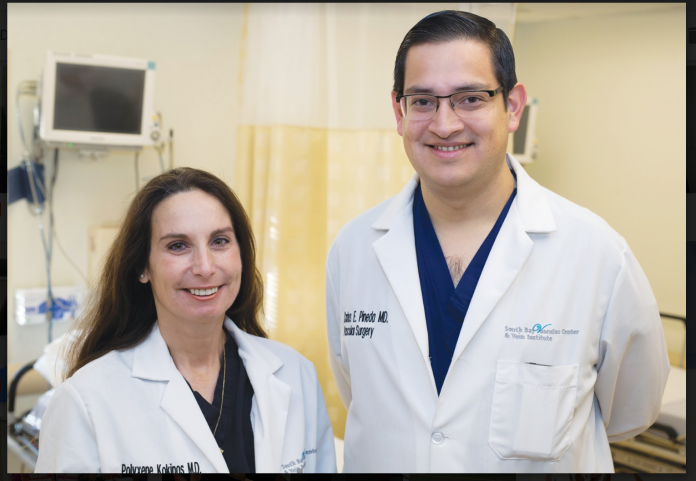
One day, Dr. Polly Kokinos, a vascular surgeon at South Bay Vascular Center, with offices in Gilroy and Campbell, was stunned when a man from a Gilroy nursing home rolled up in his wheelchair.
He was suffering from a wound that had been festering for months and the stench from it filled the room.
“You could see bone and tendons,” said Dr. Kokinos. “There is no option for the patient at that point. You wonder why someone had not sent him earlier to get help.”
Dr. Kokinos and her partner, vascular surgeon, Dr. Carlos E. Pineda, see things like this more often than they’d like. Patients with diabetes, who are more prone to hardening of the arteries, with untreated wounds on their feet. The restricted blood flow leads to infections and without proper medical intervention, patients can end up losing a toe, foot or leg.
“That’s not okay,” said Dr. Kokinos. “Especially since there is so much technology out there right now to do less invasive things.”
Diabetes, which is the number one cause of amputation and kidney failure in the U.S., has become an epidemic in the country–29 million people in the United States have the disease, according to the CDC. In 2012 alone, 1.7 million people aged 20 years or older were newly diagnosed.
A UCLA study last year found that 8 percent of Gilroyans reported they suffered from diabetes. A 2012 study found that with 14 percent of the population suffering from diabetes, Gilroyans had the highest rate out of four cities profiled by the County Health Department, including San Jose (12 percent) and Mountain View (8 percent).
The group has plenty of need for its work and protecting people from the most dire consequences of the blood sugar disease.
“If you are diabetic, someone needs to look at your feet every day,” said Dr. Kokinos. “Look for wounds or scrapes. A lot of patients don’t feel it. Then that small tear in the skin turns into a large wound. Then gangrene sets in, then amputation.”
Also, stop smoking. “Before you get to this point, take care of your diabetes and high blood pressure and stop smoking. Everyone knows cigarettes cause lung cancer but not a lot of people are aware that cigarettes kill your blood vessels and can cause amputation.”
Another issue the doctors see all the time is Deep Vein Thrombosis, when a blood clot forms, usually in the legs.
“Deep Vein Thrombosis (DVT) is a huge and completely under diagnosed problem in the US,” said Dr. Kokinos. “For patients who are undergoing total hip or total knee replacements, if you don’t give them blood thinners before their surgery, 80 percent will have a blood clot or DVT. Forty percent of cancer patients have a DVT. The numbers are huge.”
Dr. Kokinos also tells patients not to accept varicose veins and other vein related conditions as just another part of aging.
Forty to fifty million people have leaky valves or venous issues in the United States and while some spider veins are cosmetic in nature, they can also be a sign of a bigger problem that should be checked out by a trained practitioner.
“Technology has developed incredibly over the last 10 years,” said Dr. Kokinos. “There are options out there. We want patients to understand, this is not just aging. It’s not okay to use your leg or lose your toe. It’s not okay to have a wound that doesn’t heal for six months. You should seek more care than just salve.”
If a patient does get a diagnosis that requires amputation, Dr. Kokinos said to always get a second opinion.
“Never accept amputation as the only option unless your leg is literally hanging off by a thread after an accident or you are not at all ambulatory to begin with,” said Dr. Kokinos via email. “Get a second opinion. Find a vascular surgeon who does this type of work. Ask questions. You can’t ever reattach a leg so even though the pain may be awful, spend some time finding out what is available.”
Kokinos said that about half of the people who end up with an amputation because of arterial disease do so without a proper evaluation, “which is horrible.”
One of those patients could very well have been Santa Clara resident, Douglas Elwood who, because of a chronic condition that makes his blood coagulate too fast, was diagnosed with a blood clot in his leg and was told he’d need to have his leg amputated, above the knee.
Not only is above the knee a terrible place to get an amputation, Elwood already had his other leg amputated eight years years ago, the result of a previous blood clot.
“Above knee patients never walk,” said Dr. Kokinos. “To walk with a single below knee amputation takes four times the energy that it takes [people with two limbs], above the knee it is ten times.”
After his first amputation, below the knee, Elwood became an amputee mentor to several Bay Area hospitals. He led physical fitness seminars, worked as an adaptive trainer to get folks into the “best shape possible,” and gave seminars and talks to businesses and organizations about overcoming adversity.
“I came to terms with being an amputee,” he said. “I was almost a professional amputee.”
This new life came to an abrupt halt three months ago, when the 67-year old was told, within 24 hours of being diagnosed at Santa Clara Valley Medical Center in San Jose, that he would lose his remaining leg.
“I was absolutely blown and discouraged,” said Elwood, who is not a smoker or diabetic, and as an amputee mentor had become familiar with hospital staff and doctors. “I was encouraged they’d be able to save my leg. I was surprised when they said they’d have to amputate and at the worst possible position, above the knee.”
A fortuitous run-in with Dr. Kokinos at the wound care clinic at O’Connor Hospital in San Jose just days before he was supposed to go in for surgery, changed the course of his life.
Recently appointed the clinic’s new director, Dr. Kokinos took a look at Elwood’s chart, called up Valley Medical to have a long chat with the vascular surgeon who scheduled his amputation, then, on the day he was supposed to get his leg amputated, Elwood is instead in Campbell being treated by Dr. Kokinos and Dr. Pineda at their state-of-the-art angiography suite.
Elwood’s leg is saved.
“The procedure took just under four hours [seven hours including preparation and recovery],” said Dr. Kokinos. “What we did was open the main artery in his thigh called the superficial femoral artery with a laser and stent and then used balloons to open a tibial artery in his calf. This allowed more blood flow to get to his foot.”
Dr. Kokinos does not fully understand why the surgeon who diagnosed Elwood jumped on amputation, but attributes it partly to experience.
“The surgeon there is about five years younger than me, but just assumed based on the angiogram – a special X-ray picture he took that nothing was possible,” Dr. Kokinos explained. “Both Dr. Pineda and I have gone to special courses to learn how to do this more advanced type of revascularization. He had not. It takes a special focus and commitment to do this type of procedure.”
Dr. Kokinos explained that while performing an amputation is an easy 45 minute operation, it ends up being much more expensive in the long term than a revascularization.
Less than a month later, Elwood remains astounded over his close call.
“If it hadn’t been for coincidental little nuances I would be in a wheelchair today,” he said. “[Amputation] has almost become a standard procedure instead of a last resort.”
Reach the South Bay Vascular Center & Vein Institute at (408) 376-3626 or southbayvascular.com












